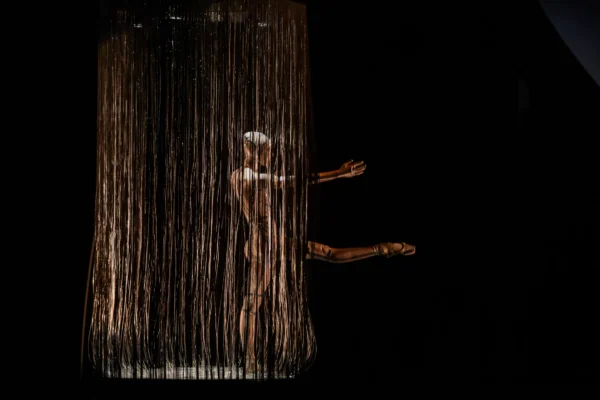AN UPDATE COPPÉLIA ABOUT A.I.
IS ALL INTELLIGENCE AND NO ARTIFICE
Coppélia — a comic ballet from 1870 with music by Léo Delibes and libretto by Charles-Louis-Étienne Nuitter — is produced quite often, either in a classical vein a la Giselle, or with updates to make the story relevant to a particular era. Opening tonight and running through Sunday at Segerstrom in Costa Mesa is a two-act Artificial Intelligence version from choreographer Jean-Christophe Maillot and Les Ballets de Monte-Carlo, which goes even further by placing us in a world that looks like a minimalist Fritz Lang epic with the wardrobe of Funny Face. And it’s a gorgeous wonder.
The strange title, at least for American audiences, may be hard to discern, as the dolls name is now Coppél-i.A. — it’s still pronounced the same but it’s a portmanteau in French: Coppél intelligence artificielle.
The original Coppélia is based on E.T.A. Hoffmann’s short story “The Sandman.” Another short story from Hoffmann inspired that little thing called The Nutcracker, but instead of Drosselmeyer, a toy maker who designs mechanical dolls, we have — depending on the interpretation — a Doctor or Scientist or Neighborhood Weirdo named Dr Coppélius who brings a life-sized doll to life. Nearby, although Franz is going to marry Swanhilda during a festival, he develops a strange attraction to the doll. Swanhilda and her friends creep into Dr Coppélius’s home, and — in dressing up as the doll Coppélia — Swanhilda wins Franz back completely. But the doll falls to the ground lifeless. All is forgiven when an angry Coppélius is compensated, and there’s a merry dance to celebrate the wedding. Done straightforward, the ballet can be excessively dainty, delicate, and quaint.
Interpolating Delibes’ perfectly charming score with original atmospheric music by Jean-Christophe’s brother, Bertrand Maillot, the bones of the story are intact, but now we have a Back to the Future-like trenchcoat-wearing man of science, Coppélius (Matej Urban), who builds a doll with A.I. and falls in love with the creature, Coppél-i.A. (Lou Beyne). The doll can’t return his love, so to make her more human somehow, he ingratiates himself into the festivities surrounding the wedding of Frantz (Simone Tribuna) and Swanilda (Anna Blackwell). Frantz is infatuated with the doll, causing consternation for Swanilda’s mother (Mimoza Koike). Swanilda and her chums sneak into Coppélius’s home, where she dresses up as Coppélia — removing Frantz’s trance. They depart for happiness leaving a destitute Coppélius.
Central to this new story is a battle of wills between Coppélia and Coppélius, making the romantic relationship of Frantz and Swanilda less important. Maillot is asking us to wonder if A.I. could the death of romance.
Bathed in the color of lightning by Maillot and Samuel Thery, Aimée Moreni‘s set consists of giant white moveable concentric arches, which will give way to black. Later the two will mix together. Upstage is a large, circular see-through gauzy fabric. With very few set pieces to speak of, there are three electric cages in Coppélius’s workshop where he builds his A.I. beings. This chameleonic space-age decor changes almost imperceptibly, and since Maillot has excised the third act (which doesn’t make much sense anyway), he adds a creepy Frankenstein-esque denouement with — and I’m not kidding here — one of the most striking endings I’ve ever seen in a narrative ballet. It’s a slo-mo movement of set and dancer not unlike the glorious minimalist work in Einstein on the Beach. Along with Moreni’s black-and-white dazzling Parisian, sci-fi haute couture costumes for the wedding party, and tight nude and metallic leotards for the A.I. androids, the space remains wide open, emphasizing the amazing performers.
The takeaway is clear: Will A.I. replace us or make us more human? But aside from that ending, it is the original, quirky choreography — always based in classical ballet — and the profoundly amazing dancers, especially Beyne, who delivers an entirely new vocabulary of stilted dance — that made this a production for the ages.
photos by Alice Blangero
Coppél-i.A.
Les Ballets de Monte-Carlo
Renée and Henry Segerstrom Concert Hall, 600 Town Center Drive in Costa Mesa
ends on March 10, 2024
for tickets, call (714) 556-2787 or visit SCFTA
for more info, visit Les Ballets de Monte-Carlo












